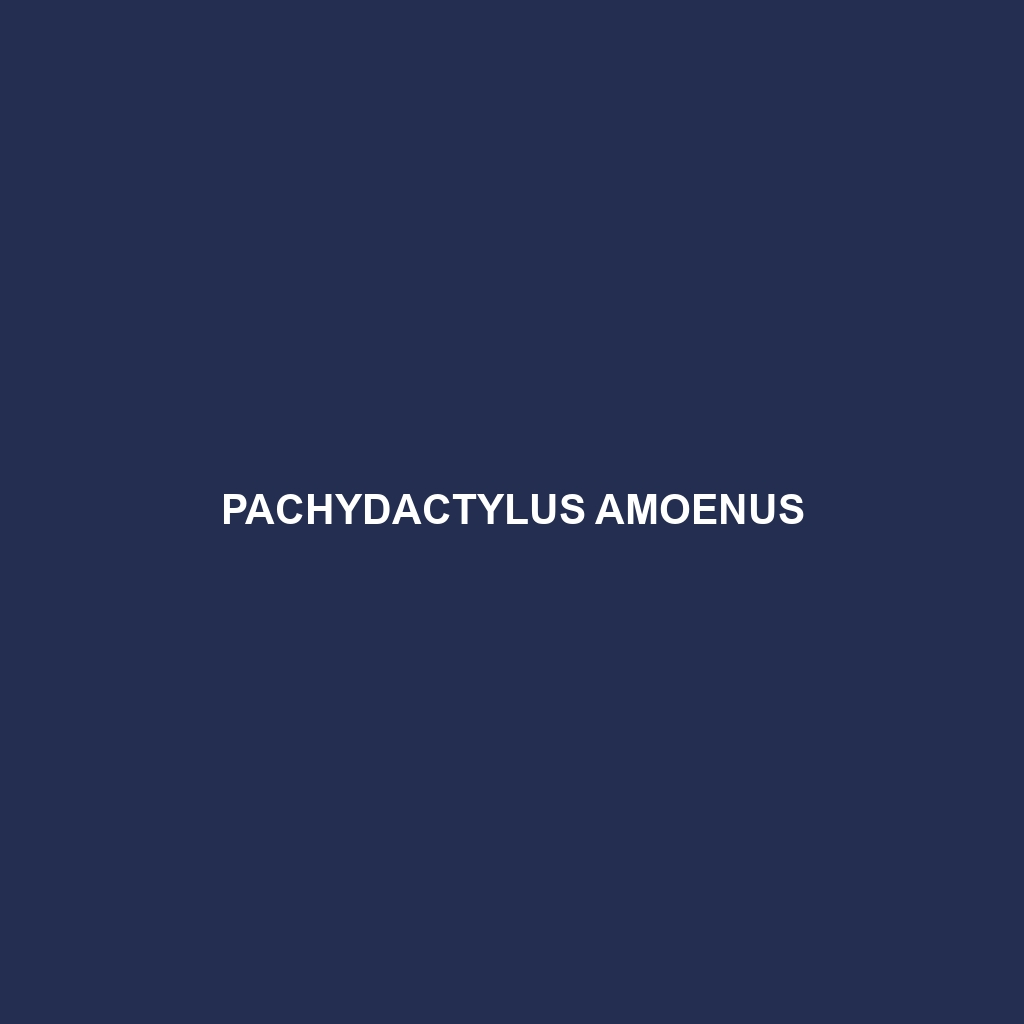Common Name
Pachydactylus amoenus
Scientific Name
Pachydactylus amoenus
Habitat
Pachydactylus amoenus, commonly known as the beautiful thick-toed gecko, is primarily found in the arid and semi-arid regions of southern Africa. These geckos inhabit a variety of environments including savannas, scrublands, and rocky outcrops. They are most often seen in areas with sparse vegetation, as it provides both shelter and hunting grounds. The climate in these regions can be characterized by hot, dry summers and mild winters. Often, they can be found hidden among rocks or under debris, which offers protection from both predators and extreme environmental conditions.
Physical Characteristics
Pachydactylus amoenus exhibits some unique physical characteristics that make it easily identifiable. Adults typically range from 8 to 12 centimeters in length. They have a stout body with broad, flat heads, and distinctively thickened toes, which give them excellent climbing abilities. The coloration of this species is predominantly light brown or sandy with darker brown spots that allow them to blend seamlessly into their natural habitat. This cryptic coloration serves as an effective camouflage against predators. Additionally, their skin is adorned with small, granular scales that provide texture and protection.
Behavior
The behavior of Pachydactylus amoenus is particularly intriguing. These geckos are primarily nocturnal, becoming active in the cooler nighttime temperatures. During the day, they typically retreat to their hiding spots under rocks or crevices to avoid the heat of the sun. They are solitary creatures, although they may occasionally be seen basking together in small numbers. Their mating rituals involve intricate courtship displays, where males perform head bobs and vocalizations to attract a mate. They are also known for their agile movements, which aid in both hunting and evading predators.
Diet
Pachydactylus amoenus is considered an insectivore, primarily feeding on various insects and small invertebrates. Their diet predominantly includes crickets, beetles, and moths, which they capture using their quick reflexes and sticky tongues. They are also known to consume small arthropods. This gecko’s feeding patterns highlight its role as an important predator within its ecosystem, helping to control insect populations.
Reproduction
The reproductive cycle of Pachydactylus amoenus typically occurs during the warmer months when conditions are more favorable for offspring survival. Mating occurs in spring, with females laying one or two eggs per clutch in shallow burrows. The eggs undergo an incubation period of approximately 60 to 90 days, after which young geckos emerge. These hatchlings are independent from birth, receiving no parental care, and they begin to hunt for food almost immediately. This reproductive strategy enhances their chances of survival in a challenging environment.
Conservation Status
As of the latest assessments, Pachydactylus amoenus is classified as being of least concern according to the International Union for Conservation of Nature (IUCN). Although their populations are stable, they are threatened by habitat destruction due to agricultural expansion and urbanization. Conservation efforts are focused on preserving their natural habitats and promoting awareness about sustainable land use practices. Continuous monitoring is essential to ensure that their populations remain stable in the face of environmental changes.
Interesting Facts
One fascinating aspect of Pachydactylus amoenus is its ability to adapt to varying habitat conditions. They can often change their activity patterns based on the availability of food and environmental pressures. This adaptability not only helps them survive but also makes them a resilient species in a changing world. Additionally, they are capable of dropping their tails as a defense mechanism, allowing them to escape predators while the detached tail continues to wriggle, distracting the threat.
Role in Ecosystem
Pachydactylus amoenus plays a significant role in the ecosystem as both a predator and prey. As an insectivore, it helps regulate insect populations, maintaining a balance within its habitat. This gecko is also a food source for larger predators, including birds of prey and snakes, thus contributing to the food web. By acting as a predator, Pachydactylus amoenus helps promote biodiversity, ensuring a healthy and functioning ecosystem. Their presence indicates a well-balanced environment, which is crucial for ecology.
